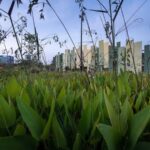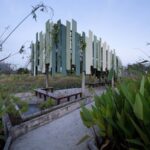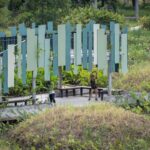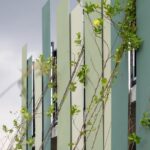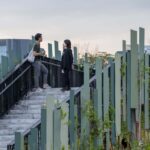Enhancing Bangkok’s Green Spaces: Benchakitti Rain Forest Observatory
Introduction
In response to Bangkok’s insufficient green space per capita, the Benchakitti Rain Forest Observatory emerges as a testament to architectural innovation and environmental stewardship. Designed by HAS design and research, this project situated within Benchakitti Forest Park offers a transformative experience that integrates architecture seamlessly with nature.

Addressing Urban Green Space Deficiency
With Bangkok falling short of the World Health Organization’s recommended green space standards, the Benchakitti Rain Forest Observatory fills a crucial gap by providing citizens with a verdant oasis in the heart of the city. Its opening in 2022 signifies a commitment to enhancing the well-being and lifestyle of Bangkokians through access to green open spaces.

Embracing Natural Harmony
Inspired by the lush surroundings of Benchakitti Forest Park, the observatory embodies the spirit of its environment. HAS design and research envision the structure not as an imposition on nature but as an extension of it, blending seamlessly into the landscape like a floating wetland island.
Architectural Integration
The observatory’s design mimics the organic forms of leaves, creating a structure that appears to emerge naturally from its surroundings. Visitors are guided through undulating pathways that lead to elevated observation decks and serene rest areas, offering opportunities for reflection and engagement with nature.

Sustainable Design Solutions
During the day, the observatory adopts a chameleon-like quality, blending harmoniously with its surroundings through the use of sustainable paint in varying shades of green. At night, concealed lighting strips illuminate the structure subtly, allowing it to disappear into the darkness and preserving the natural ambiance of the park.

Community Engagement and Education
Beyond its architectural significance, the Benchakitti Rain Forest Observatory serves as a hub for community gatherings, educational events, and cultural activities. It not only provides essential shading and recreational functions but also fosters a deeper connection between citizens and their natural environment.
Conclusion
The Benchakitti Rain Forest Observatory stands as a beacon of hope and inspiration, demonstrating the power of design to enhance urban landscapes and promote environmental stewardship. By reimagining the role of architecture within natural settings, HAS design and research have created a sanctuary where Bangkokians can reconnect with nature, foster community bonds, and cultivate a sustainable future for generations to come.

